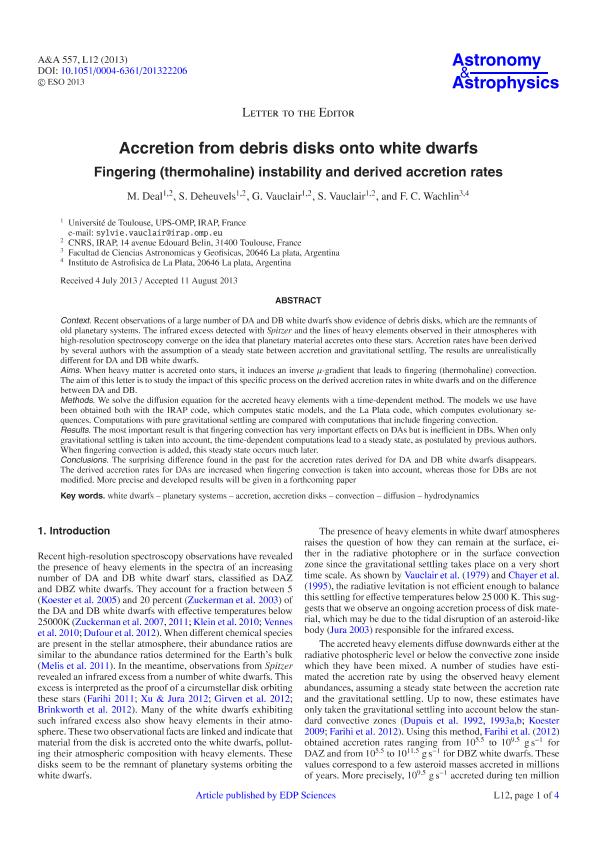Mostrar el registro sencillo del ítem
dc.contributor.author
Deal, M.
dc.contributor.author
Deheuvels, S.
dc.contributor.author
Vauclair, G.
dc.contributor.author
Vauclair, S.
dc.contributor.author
Wachlin, Felipe Carlos

dc.date.available
2016-11-30T18:37:07Z
dc.date.issued
2013-09
dc.identifier.citation
Deal, M.; Deheuvels, S.; Vauclair, G.; Vauclair, S.; Wachlin, Felipe Carlos; Accretion from debris disks onto white dwarfs. Fingering (thermohaline) instability and derived accretion rates; Edp Sciences; Astronomy And Astrophysics; 557; 4; 9-2013; 1-4
dc.identifier.issn
0004-6361
dc.identifier.uri
http://hdl.handle.net/11336/8524
dc.description.abstract
Context. Recent observations of a large number of DA and DB white dwarfs show evidence of debris disks, which are the remnants of old planetary systems. The infrared excess detected with Spitzer and the lines of heavy elements observed in their atmospheres with high-resolution spectroscopy converge on the idea that planetary material accretes onto these stars. Accretion rates have been derived by several authors with the assumption of a steady state between accretion and gravitational settling. The results are unrealistically different for DA and DB white dwarfs. Aims. When heavy matter is accreted onto stars, it induces an inverse μ-gradient that leads to fingering (thermohaline) convection. The aim of this letter is to study the impact of this specific process on the derived accretion rates in white dwarfs and on the difference between DA and DB. Methods. We solve the diffusion equation for the accreted heavy elements with a time-dependent method. The models we use have been obtained both with the IRAP code, which computes static models, and the La Plata code, which computes evolutionary sequences. Computations with pure gravitational settling are compared with computations that include fingering convection. Results. The most important result is that fingering convection has very important effects on DAs but is inefficient in DBs. When only gravitational settling is taken into account, the time-dependent computations lead to a steady state, as postulated by previous authors. When fingering convection is added, this steady state occurs much later. Conclusions. The surprising difference found in the past for the accretion rates derived for DA and DB white dwarfs disappears. The derived accretion rates for DAs are increased when fingering convection is taken into account, whereas those for DBs are not modified. More precise and developed results will be given in a forthcoming paper
dc.format
application/pdf
dc.language.iso
eng
dc.publisher
Edp Sciences

dc.rights
info:eu-repo/semantics/openAccess
dc.rights.uri
https://creativecommons.org/licenses/by-nc-sa/2.5/ar/
dc.subject
White Dwarfs
dc.subject
Planetary Systems
dc.subject
Accretion Disks
dc.subject
Convection
dc.subject
Diffusion
dc.subject
Hydrodynamics
dc.subject.classification
Otras Ciencias Naturales y Exactas

dc.subject.classification
Otras Ciencias Naturales y Exactas

dc.subject.classification
CIENCIAS NATURALES Y EXACTAS

dc.subject.classification
Otras Ciencias Naturales y Exactas

dc.subject.classification
Otras Ciencias Naturales y Exactas

dc.subject.classification
CIENCIAS NATURALES Y EXACTAS

dc.title
Accretion from debris disks onto white dwarfs. Fingering (thermohaline) instability and derived accretion rates
dc.type
info:eu-repo/semantics/article
dc.type
info:ar-repo/semantics/artículo
dc.type
info:eu-repo/semantics/publishedVersion
dc.date.updated
2016-11-18T15:10:44Z
dc.journal.volume
557
dc.journal.number
4
dc.journal.pagination
1-4
dc.journal.pais
Francia

dc.journal.ciudad
Paris
dc.description.fil
Fil: Deal, M.. Université de Toulouse; Francia
dc.description.fil
Fil: Deheuvels, S.. Université de Toulouse; Francia
dc.description.fil
Fil: Vauclair, G.. Université de Toulouse; Francia
dc.description.fil
Fil: Vauclair, S.. Université de Toulouse; Francia
dc.description.fil
Fil: Wachlin, Felipe Carlos. Consejo Nacional de Investigaciones Científicas y Técnicas. Centro Científico Tecnológico la Plata. Instituto de Astrofísica de la Plata; Argentina. Universidad Nacional de la Plata. Facultad de Ciencias Astronómicas y Geofísicas; Argentina
dc.journal.title
Astronomy And Astrophysics

dc.relation.alternativeid
info:eu-repo/semantics/altIdentifier/url/http://www.aanda.org/articles/aa/abs/2013/09/aa22206-13/aa22206-13.html
dc.relation.alternativeid
info:eu-repo/semantics/altIdentifier/doi/http://dx.doi.org/10.1051/0004-6361/201322206
Archivos asociados
